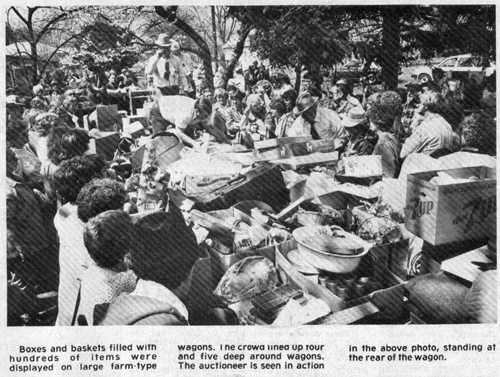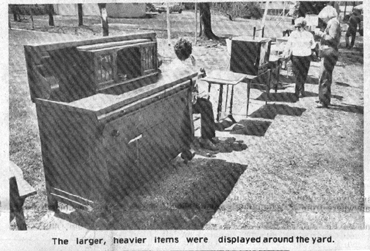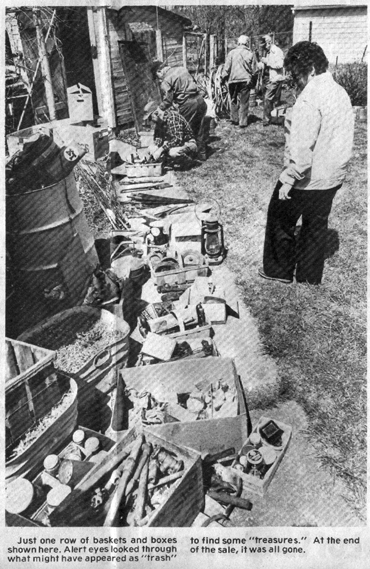May 12, 1983



Picture #1 – Boxes and baskets filled with hundreds of items were displayed on large farm-type wagons. The crowd lined up four and five deep around the wagons. The auctioneer is seen in action in the above photo, standing at the rear of the wagon.
Picture #2 – The larger, heavier items were displayed around the yard.
Picture #3 – Just one row of baskets and boxes shown here. Alert eyes looked through what might have appeared as “trash” to find some “treasures”. At the end of the sale, it was all gone.
Our family just went through our first experience of getting ready for a public auction (hopefully our last) to settle up the estate of an aunt, Lulu Brumbaugh, Tiffin, who would have been 105 if she had lived until April 30.
I can say there were many surprises, but mostly a lot of hard work – sorting through drawer after drawer, in every room, from top to basement, garage and workshop.
Ned Gregg, Sycamore, the auctioneer, guided us through preparation, emphasizing, don’t throw away anything because “you’re trash may be someone else’s treasure”.
So, we sorted like objects into groups. On the day of the sale, the auctioneer’s crew arranged items to get the best attention getters and to bring the highest dollar return.
The regular household furniture, many pieces antiques, brought good prices, especially blanket chests, a china cabinet with round glass sides and many pieces of glassware which aunt Lulu and uncle Taylor had collected.
When we looked through items in the basement, we discovered an old drop leaf table, dry sink, three old valuable cupboards, two camelback trunks, a number of matching chairs to accommodate caned seats, all of which brought very good prices. there were also many garden and shop tools.
Getting ready for the sale, we spent many days and nights at the house. I was amazed at two items on the bed in which I slept. Once was a heavy wool double blanket. By double, I mean that it was twice the length of a regular blanked, folded at the foot so that it would never need tucking in. The other unusual items were two feather-filled pillows which were the full width of the double bed. No gaps like with regular pillows.
Many years ago, uncle Taylor repaired his own shoes and probably those of kids who needed repairs but couldn’t afford them. And among the many items in his shop were the shoemaker’s tools he used – awls, nails, hammers, leather, heels and various size lasts.
Uncle Taylor had a small potbelly stove in his shop. He could go there in winter or summer to do as he pleased. And he did. He read newspapers, flower and seed catalogues, books on animal husbandry and home remedies for a variety of ailments. I found something on all those subjects plus many others.
He also clipped and save obituaries, church events, golden wedding reports and recipes. Among the obituaries, I found one for Dr. Arvine Harrold and his mother. The Brumbaughs were friends of the Ed Harrold family when they came to Fostoria and started their undertaking business.
I never knew uncle Taylor was a Kentucky Colonel until I found the certificate naming him as one many years ago. It was tucked away in his shop among other papers.
For many years, Taylor was active on the Seneca County Fair Board. Later because of his contribution to the board, he was awarded a pass which allowed him to visit any fair in Ohio. Getting around to so many fairs, he had quite a collection of match books, pencils, memo books, political badges and buttons – all stashed away in his shop.
In the house we found a very nice walking cane with what appeared to be a silver handle with the inscription “Heidelberg College – 1899”. It was turned over to the college for their memorabilia room. Since then, Kathyrn Brumbaugh, daughter and the only survivor, has received a nice acknowledgement.
I also received several items from the state, including a gold headed cane with Masonic emblems which belonged to Mrs. Krupp’s grandfather, George Washington Allis, when he was a member of the lodge at Baltimore; Kodak folding camera (3 X 5), a real nice relic with excellent lenses; church song books with old favorites, dating back to the turn of the century with photos of Billy Sunday and his staff, including Homer A. Rodeheaver, the great song evangelist; and postcards and booklets with historical value.
Years ago when there were many glass plants in Fostoria, the Brumbaughs lived in Fostoria and Taylor worked in the one plant where light bulbs were made. We discovered two of the incandescent lamps made there. With the one which I inherited was a note written by Taylor on Nov. 8, 1904: “This bulb was blown by Taylor Brumbaugh in fostoria, Ohio, and finished at the lamp factory there”. the bulb has a label “Fostoria Mazda”. A sticker on it identified it as 250 watt. From the screw-base to the top of the blown glass enclosure is 15 3/4 inches.
The building where the Fostoria Mazda lamps were made still exists on South Poplar Street at the B&O Railroad tracks. “Fostoria Incandescent Lamp Works” can still be seen on the streetside of the building at top. That factory was later purchased by General Electric Co. and moved to Cleveland. Some Fostorians moved to Cleveland at that time. H.H. Geary Sr., an employee and early stockholder of the Fostoria factory, profited greatly by his investments.
The 89-year old lamp bulb will be donated to the Fostoria Area Historical Society for the museum.
From 11 a.m. to 5 p.m., the auctioneer’s rapidly spoken lingo continued. He signified with his hands certain signs which the excited audience of approximately 400 seemed to understand, and they returned with nods or signs.
“Trash and treasures” continued to sell briskly as the auctioneer had predicted. Finally left was an antique easy electric washer, perhaps 40 or more years old, which although no longer used was still operable. No one wanted it. Neither could be give it or two fairly new mattresses away. They were hauled away to the dump site. Later we learned that some needy families could have used the mattresses.
I could go on listing hundreds of other items which were gobbled up by the crowd – even nails, screws, bolts, all kinds of hardware, etc.
The women from St. Paul’s Methodist Church served lunch and did a brisk business. The event seemed most like a circus. Buyers came from various points in Ohio, Michigan and Indiana.
It was a great experience which many readers probably know about. But for those without experience, this article will provide a look at will happen.
But, when it was all over and all of the Brumbaughs possessions sold and the crowd was gone, it was time for reflection – the end of an era for the family. I first met the Brumbaughs in 1913 at the time of a floor. Wilbur Sheely, my boyhood friend and his parents took me with them to Tiffin to view the flood disaster.
Many years later, Lulu and Taylor became aunt and uncle to me when I married their niece, Cleo May Allis. Memories we can always keep.